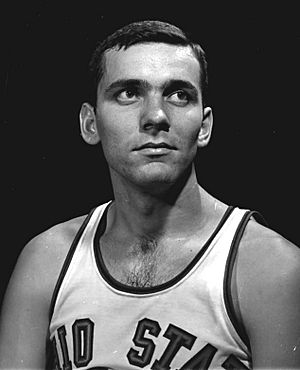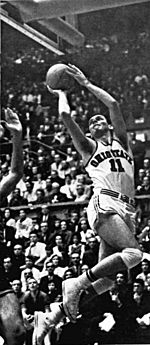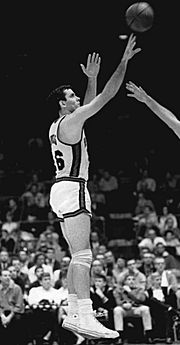Jerry Lucas facts for kids

Lucas in 1961
|
||||||||||||||
| Personal information | ||||||||||||||
|---|---|---|---|---|---|---|---|---|---|---|---|---|---|---|
| Born | March 30, 1940 Middletown, Ohio, U.S. |
|||||||||||||
| High school | Middletown (Middletown, Ohio) | |||||||||||||
| Listed height | 6 ft 8 in (2.03 m) | |||||||||||||
| Listed weight | 230 lb (104 kg) | |||||||||||||
| Career information | ||||||||||||||
| College | Ohio State (1959–1962) | |||||||||||||
| NBA Draft | 1962 / Pick: territorial pick | |||||||||||||
| Selected by the Cincinnati Royals | ||||||||||||||
| Pro career | 1962–1974 | |||||||||||||
| Career history | ||||||||||||||
| 1963–1969 | Cincinnati Royals | |||||||||||||
| 1969–1971 | San Francisco Warriors | |||||||||||||
| 1971–1974 | New York Knicks | |||||||||||||
| Career highlights and awards | ||||||||||||||
|
||||||||||||||
| Career NBA statistics | ||||||||||||||
| Points | 14,053 (17.0 ppg) | |||||||||||||
| Rebounds | 12,942 (15.6 rpg) | |||||||||||||
| Assists | 2,732 (3.3 apg) | |||||||||||||
|
Medals
|
||||||||||||||
Jerry Ray Lucas (born March 30, 1940) is a famous American former basketball player. He was an amazing player in high school and college. He also won a gold medal at the 1960 Olympics. Later, he became a star in the National Basketball Association (NBA).
In college, Jerry Lucas led the Ohio State Buckeyes to three straight championship games. They won the national championship in 1960. He was named the best college player in 1961 and 1962.
As a professional, Lucas was chosen for the All-NBA First Team three times. He was also an NBA All-Star seven times. He won the NBA Rookie of the Year award in 1964. In 1980, he was added to the Naismith Memorial Basketball Hall of Fame.
Contents
Early Life and Basketball Dreams
Jerry Ray Lucas was born on March 30, 1940, in Middletown, Ohio. This town was known as "The Basketball Capital of Ohio." Its high school basketball teams were very successful.
Jerry was a tall kid and loved basketball. He spent a lot of time practicing. By age 15, he was 6 feet 7 inches tall. He even played against college players in summer games. This helped him get much better at basketball.
Jerry was also very smart. He was an A-student and loved to memorize things. He even made up memory games for himself. He used his smarts to understand basketball plays too.
High School Basketball Star
Jerry Lucas started playing for Middletown High in 1955. Even as a sophomore, he was an amazing athlete. He was great at getting rebounds and passing the ball. He also scored a lot of points.
His team, the Middies, was undefeated in his first two years. They won the state championship in 1956 and 1957. One game drew over 13,000 fans, which was a huge crowd back then!
Jerry was known for making 60% of his shots and 75% of his free throws. He only lost one game in his senior year. This ended a record-breaking 76-game winning streak. Jerry scored 2,460 points in high school. He was one of the most famous high school players in the country.
College Success at Ohio State
Many colleges wanted Jerry Lucas to play for them. He chose Ohio State University. He joined a special group of players in 1958. This group included future Hall of Famer John Havlicek.
Jerry was a great student and insisted on an academic scholarship. He even helped Ohio State football players with their studies.
In 1959, Jerry and his teammates started playing for the Ohio State varsity team. They were a very strong team. They scored about 90 points per game. In 1960, they won the NCAA national championship. Jerry averaged 26 points and 16 rebounds per game. He was named the Most Outstanding Player of the tournament.
In 1961, Ohio State had a 32-game winning streak. Jerry had an amazing game where he scored 33 points and grabbed 30 rebounds. This is called a "30-30" game. It's still the only time a college player has done this in an NCAA tournament game. But they lost in the finals that year.
By 1962, Jerry had played basketball almost non-stop for two years. He was tired and had sore knees. He had said he would never play professionally. Even with an injury, he played in the 1962 NCAA final, but Ohio State lost again.
Jerry was named an All-American First Team player all three years at Ohio State. His jersey number 11 was retired by the college. Many people still think he is the greatest player in the Big Ten conference.
Olympic Gold Medalist
After winning the NCAA championship in 1960, Jerry Lucas was chosen for the 1960 U.S.A. Olympic team. This team played in the Rome Games.
Jerry became the starting center for the U.S. team. They played against the Soviet Union and won. In the gold medal game against Brazil, Jerry scored 21 points. The U.S. team won the gold medal!
His coach, Pete Newell, called Jerry "the greatest player I ever coached." The team also had other future NBA stars like Jerry West and Oscar Robertson.
Jerry also played in other international games. In 1961, he toured the Soviet Union with a team of U.S. players. They won all eight games. In 1964, he toured Europe with a team of NBA players.
Professional Basketball Career
Jerry Lucas didn't always want to be a professional basketball player. In 1962, two different leagues wanted him. The Cincinnati Royals in the NBA had the rights to him. But Jerry didn't sign with them at first.
Playing for the Cincinnati Royals
In 1963, Jerry finally signed with the Cincinnati Royals. His signing made ticket sales for the team double!
The 1963–64 Royals team was very strong. Jerry played as a power forward. He was great at rebounding and passing. He also led the league in shooting accuracy as a rookie. He even had a game where he grabbed 40 rebounds! He is still the only NBA forward to do this.
In his second season, Jerry was asked to score more. He had his best seasons in Cincinnati, averaging over 21 points and 20 rebounds per game. These are still amazing numbers for an NBA forward. He played a lot of minutes in games, even with knee pain.
In 1965, Jerry was named the Most Valuable Player of the NBA All-Star Game. He scored 26 points in that game.
Later, Jerry faced some financial challenges with his investments. This was a tough time for him.
Time with the San Francisco Warriors
In 1969, Jerry moved to the San Francisco Warriors. He had a tough season in 1969–70 because of a broken hand. But he came back strong in 1970–71. He averaged 19.2 points and 15.8 rebounds per game. He was chosen for the NBA All-Star Game for the seventh and final time. The Warriors made the playoffs that year.
Winning a Championship with the New York Knicks
In 1971, Jerry Lucas joined the New York Knicks. The Knicks needed a big player to help their team. When their starting center, Willis Reed, got injured, Jerry stepped up. He became the smallest center in the league.
Even at 31 years old, Jerry had one of his best professional seasons. He led the Knicks in rebounds and shooting accuracy. His long-range shots made opponents change their defense. The Knicks made it to the 1972 NBA finals but lost.
In 1972–73, Willis Reed returned. Jerry played less, but he still helped the team. The Knicks made the NBA finals again, and this time they won!
This made Jerry Lucas one of the first players to win a championship at every level: high school, college, Olympics, and NBA. He retired from the NBA in 1974 after 11 seasons. His career average of 15.6 rebounds per game is still one of the highest in NBA history.
Jerry Lucas's Legacy
In 1980, Jerry Lucas was inducted into the Naismith Memorial Basketball Hall of Fame. In 1996, the NBA chose him as one of its 50 Greatest Players in NBA History. He was also named to the NBA 75th Anniversary Team in 2021.
Jerry Lucas is remembered as an amazing rebounder, especially for his height. He was also a big player who could shoot well from far away. This was a rare combination for players back then.
NBA Career Statistics
| Legend | |||||
|---|---|---|---|---|---|
| GP | Games played | GS | Games started | MPG | Minutes per game |
| FG% | Field goal percentage | 3P% | 3-point field goal percentage | FT% | Free throw percentage |
| RPG | Rebounds per game | APG | Assists per game | SPG | Steals per game |
| BPG | Blocks per game | PPG | Points per game | Bold | Career high |
Regular season
| Year | Team | GP | GS | MPG | FG% | 3P% | FT% | RPG | APG | SPG | BPG | PPG |
|---|---|---|---|---|---|---|---|---|---|---|---|---|
| 1963–64 | Cincinnati | 79 | — | 41.4 | .527* | — | .779 | 17.4 | 2.6 | — | — | 17.7 |
| 1964–65 | Cincinnati | 66 | — | 43.4 | .498 | — | .814 | 20.0 | 2.4 | — | — | 21.4 |
| 1965–66 | Cincinnati | 79 | — | 44.5 | .453 | — | .787 | 21.1 | 2.7 | — | — | 21.5 |
| 1966–67 | Cincinnati | 81* | — | 43.9 | .459 | — | .791 | 19.1 | 3.3 | — | — | 17.8 |
| 1967–68 | Cincinnati | 82 | — | 44.1 | .519 | — | .778 | 19.0 | 3.3 | — | — | 21.5 |
| 1968–69 | Cincinnati | 74 | — | 41.6 | .551 | — | .755 | 18.4 | 4.1 | — | — | 18.3 |
| 1969–70 | Cincinnati | 4 | — | 29.5 | .514 | — | .714 | 11.3 | 2.3 | — | — | 10.3 |
| 1969–70 | San Francisco | 63 | — | 36.5 | .507 | — | .786 | 14.4 | 2.6 | — | — | 15.4 |
| 1970–71 | San Francisco | 80 | — | 40.6 | .498 | — | .787 | 15.8 | 3.7 | — | — | 19.2 |
| 1971–72 | New York | 77 | — | 38.0 | .512 | — | .791 | 13.1 | 4.1 | — | — | 16.7 |
| 1972–73 |
New York | 71 | — | 28.2 | .513 | — | .800 | 7.2 | 4.5 | — | — | 9.9 |
| 1973–74 | New York | 73 | — | 22.3 | .462 | — | .698 | 5.1 | 3.2 | .4 | .3 | 6.2 |
| Career | 829 | — | 38.8 | .499 | — | .783 | 15.6 | 3.3 | .4 | .3 | 17.0 | |
| All-Star | 7 | 6 | 26.1 | .547 | — | .905 | 9.1 | 1.7 | — | — | 12.7 | |
Playoffs
| Year | Team | GP | GS | MPG | FG% | 3P% | FT% | RPG | APG | SPG | BPG | PPG |
|---|---|---|---|---|---|---|---|---|---|---|---|---|
| 1964 | Cincinnati | 10 | — | 37.0 | .390 | — | .703 | 12.5 | 3.4 | — | — | 12.2 |
| 1965 | Cincinnati | 4 | — | 48.8 | .507 | — | .773 | 21.0 | 2.3 | — | — | 23.3 |
| 1966 | Cincinnati | 5 | — | 46.2 | .471 | — | .771 | 20.2 | 2.8 | — | — | 21.4 |
| 1967 | Cincinnati | 4 | — | 45.8 | .436 | — | 1.000 | 19.3 | 2.0 | — | — | 12.5 |
| 1971 | San Francisco | 5 | — | 34.2 | .506 | — | .688 | 10.0 | 3.2 | — | — | 17.8 |
| 1972 | New York | 16 | — | 46.1 | .500 | — | .831 | 10.8 | 5.3 | — | — | 18.6 |
| 1973 |
New York | 17 | — | 21.6 | .482 | — | .870 | 5.0 | 2.3 | — | — | 7.5 |
| 1974 | New York | 11 | — | 10.5 | .238 | — | — | 2.0 | .8 | .4 | .0 | .9 |
| Career | 72 | — | 32.9 | .467 | — | .786 | 10.0 | 3.0 | .4 | .0 | 12.4 | |
Life After Basketball
After his NBA career, Jerry Lucas focused on publishing books and education. In 1974, he co-wrote a best-selling book called The Memory Book. He also created an educational program called the Lucas Learning System. He has written over 70 books, mostly about learning and memory.
Jerry is a committed Christian. He often gives talks at churches. He is married to Cheri Wulff, and they live in Gallipolis, Ohio.
See also
 In Spanish: Jerry Lucas para niños
In Spanish: Jerry Lucas para niños
- Mr. Basketball USA
- List of National Basketball Association career rebounding leaders
- List of National Basketball Association players with most rebounds in a game
- List of NCAA Division I men's basketball season rebounding leaders



